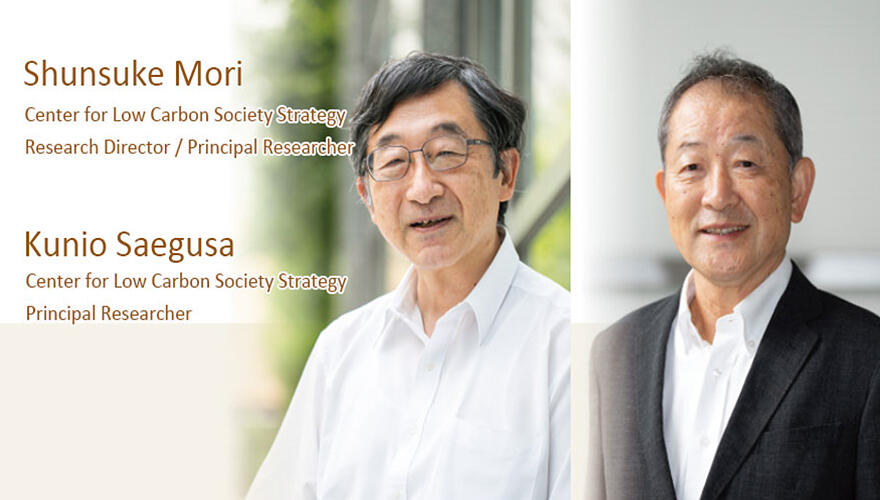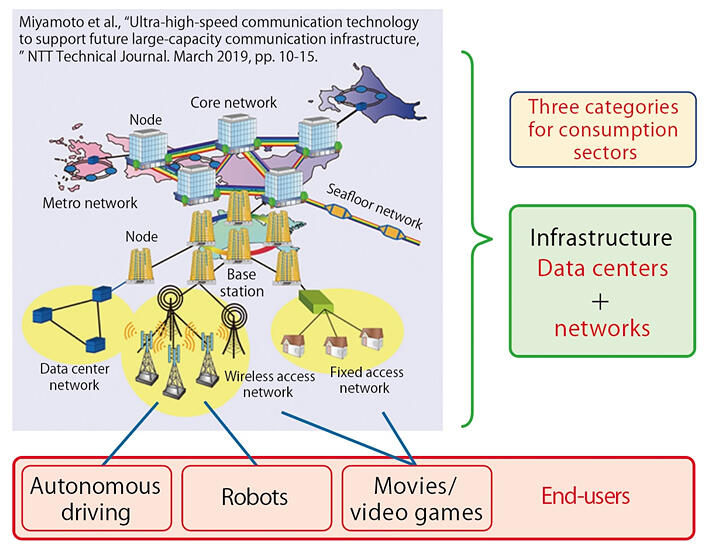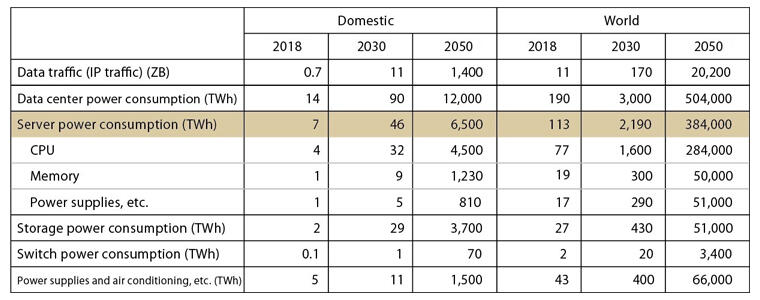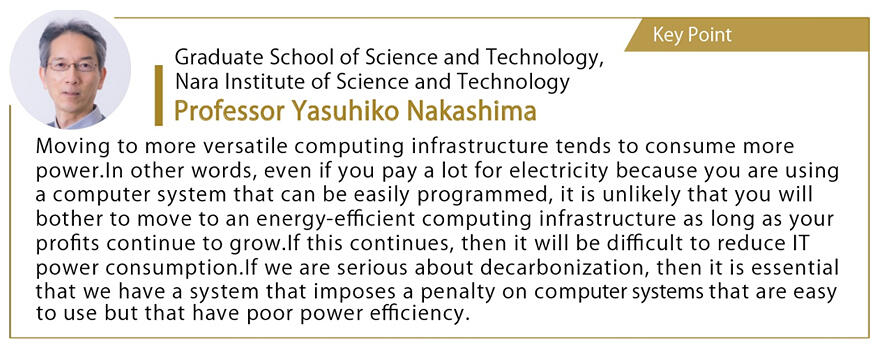This is the seventh installment in a series of stories in which Yutaka Minakawa, a young employee of a trading company, reads and analyzes proposal papers by the Center for Low Carbon Society Strategy (LCS). In the previous installment, Minakawa learned about the power storage technologies that, together with renewable energy generation, will support the foundation for zero emissions. This time he takes a look at energy consumption and interviews Research Director Shunsuke Mori and Principal Researcher Kunio Saegusa about the current state of power consumption for information and communications and talks about points for future technological developments that will support our continuously developing information society.

By 2050, the amount of information will increase to 4,000x* current levels, and electricity usage will also exceed the world's current consumption
Minakawa: Thank you for talking with me today. I have seen that a lot of companies are making investments in information and communications, such as in the fall of 2022 when a major IT company announced that they would be opening a data center in Japan. At LCS, you are analyzing the relationship between the progress of the shift to an information society and future power consumption, as well as the impacts of decarbonization, right?
Saegusa: We are trying to estimate the relationship between the amount of information sent and received on the network, called "communications traffic," and energy consumption. According to an estimate that was done in 2019, assuming that Cisco's (a major provider of information and digital communications equipment) past growth in global communications traffic is extended into the future, by 2030 communication traffic will increase by a factor of 30x from the current level, and by 2050 it will increase by a factor of 4,000x, and the power required for this would be more than the current total global power consumption.
Minakawa: So, the amount of electricity we currently produce will not be enough?
Saegusa: The rate of increase in communications traffic is an extrapolation of previous tends and current levels, and the estimated values(*) for power consumption assume that the energy-efficiency technologies for IT equipment remain at current levels, so we don't think that the future number will be like this, but, as IoT spreads and the use of AI accelerates, communications traffic will definitely increase in the future. Therefore, we structured information and communications technologies to create a model for quantitative analysis and conducted an analysis to understand the technological developments that will be needed in the future.
Minakawa: What do you mean when you say that you "structured information and communications technologies"?
Saegusa: To put it simply, information and communication systems are divided into "end users" and "infrastructure," with the infrastructure consisting of the "data centers" that perform calculations and processing, and the "network" that exchanges information (Figure 1).
Figure 1: Structure of information and communication systems

(https://www.jst.go.jp/lcs/pdf/webinar20220624-5.pdf).
Minakawa: So, as an example, when I use a map application to find a subway route, when an end user like me enters data into their smartphone, the data center calculates the optimal route for me to take and then the results are returned to me via the network, right?
Saegusa: That's correct. We identified the facilities and equipment that are the primary power-consuming elements in each sector, and then we estimated the power consumption for each element. Elements that consume large amounts of power have room for significant power reductions, so we can see that developing the technology for those elements would be effective in saving energy.
Taking a data center as an example, we first divide the data center's components into servers, storage, switches, and power supplies, and then we estimate the power consumption of each one of them from the number of related IT equipment product shipments. Including the power consumption of equipment such as air conditioning equipment, the estimated power consumption of domestic data centers in 2018 was 14 terawatts (1 terawatt is 1 trillion watts) (Table 1).
Table 1: Current and future data center power consumption

To achieve an objective scenario, validity has also been verified by experts
Minakawa: Looking at the table, the servers account for most of the power consumption in data centers, and the CPU, which is what performs the computations and calculations, seems to have a particularly significant impact.
Saegusa: You're very perceptive. By subdividing the estimate on power consumption, we can see that saving power from computing devices would be effective in reducing power consumption.
Minakawa: So, by doing this, we can see what kinds of technological development will be necessary to reduce the power consumption for information and communications.
Saegusa: We used a similar approach to make the estimates for networks in the information and communications systems model and found that research and development into wireless base stations and routers would be effective in reducing power consumption. In the future, there are also plans to aim for significant power savings and large-capacity communications not just by saving energy in existing equipment, but also by introducing quantum computers and building networks that use optical signals for information communications.
Minakawa: I was really surprised by the detailed estimations of the equipment components in the analysis.
Saegusa: That's right. In fact, it is necessary to understand both the device's mechanisms and the trends in their technological development. Because of that, we ask experts for their opinions about the validity of the statistical information that we are using, and we also try to conduct an objective analysis. If the purpose was only to estimate power consumption, then we could estimate that from the number of subscribers to telecommunications companies, etc., but we believe that the LCS's significance lies in demonstrating effective technological development, so we have taken the more difficult approach.
Information technology improves quality of life: Compensation for development of the necessary technologies
Minakawa: What about the estimates for the end-user side?
Mori: Let me tell you about this. This is an important analysis because end-user demand influences change in communications traffic. Because information and communication technologies are used in a wide range of situations, such as medical care, transportation, and entertainment, we are currently considering estimates that narrow down the field where they are being used. Before that, I would like to introduce some research that considers future communications traffic based on changes in demand for communication content in recent years and changes in lifestyles due to COVID-19.
Minakawa: Do you mean looking at trends for demand in the past to learn about demand in the future?
Mori: To see changes in end-user demand in recent years, we calculated communications traffic trends by content type (video, audio, and text) and found that video content has been a factor in the rapid increase in traffic in recent years. If this trend continues, traffic will increase at an annual rate of 20% per year by 2030. Additionally, an analysis of the impact that teleworking during the COVID-19 pandemic had on communications traffic showed that if 40% of work is being done remotely, that communication volume would increase by up to 33%.
Minakawa: In that case, power consumption would also probably increase quite a bit.
Mori: Demand in Japan may decline due to the declining population, but, if video is replaced with VR, for example, then communications traffic will increase even if the number of users remains the same. To prepare for social changes that will inevitably increase traffic, such as security and alternatives to transportation during COVID-19, it is essential to reduce the energy consumption of information and communications. On top of that, the financial aspects also cannot be ignored. Telecommunications carriers around the world are suffering from sluggish revenue per user, which may constrain the expansion of their services. In order to create appropriate user demand, it will be necessary to think about the situations in which communications technologies should be used, and to be ready to pay for the necessary technologies.
Minakawa: Online medical consultations and remote classes, which were introduced during COVID-19, have also taken root.
Mori: Those are good examples of how information and communications can eliminate "inconveniences" that we never thought about before. Although progress in the shift to an information society has increased the environmental burden, it has certainly improved the quality of life, and it has also had the effect of reducing the environmental burden, such as by optimizing supply/demand for power and reducing movement.
Minakawa: It would be interesting to sketch out a scenario that considers the level of satisfaction with lifestyle and the reduction in environmental impact.
Saegusa: I think that a more thorough analysis of the changes that happened during COVID-19 can be made if experts in human mobility, electrical power, and social productivity are also added to the analysis. So far proposal papers from the LCS have been used in the "Information and Communications in Japan White Paper" by the Ministry of Internal Affairs and Communications, and we are aware of growing social interest in this topic, so we will continue our research so that we can make even more realistic estimates.
Minakawa: Not only would we be able to increase the reliability of the power consumption estimates, but we would also have a good understanding of what kinds of technological development we should focus on in the future. I look forward to seeing your future analysis! Thank you very much for speaking with me today.
* This is a fictional narrative based on an interview.
(Text by Asami Takahashi and photos by Hideki Ishihara and Seiko Kusunoki)





